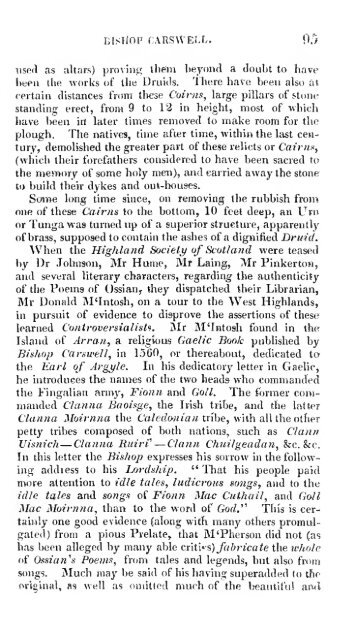An Laoidheadair Gaelic na ain spioradail
An Laoidheadair Gaelic na ain spioradail
An Laoidheadair Gaelic na ain spioradail
Create successful ePaper yourself
Turn your PDF publications into a flip-book with our unique Google optimized e-Paper software.
EISHOP CARSWELL. *l.7<br />
uspfl as altars) proving them beyoncl a doubt to have<br />
been ihe \vorks of the Druids. Ìhere have been also at<br />
cert<strong>ain</strong> distances fram tbese Coirns, large pillars of sttme<br />
stancling erect, from 9 to 12 in height, most of which<br />
have been iri later times removed to make room for the<br />
plough. The <strong>na</strong>tives, time after time, within the last century,<br />
demolished the greater part of these relicts or Cairns^<br />
(vvhich their forefathers considered to have been sacred fo<br />
the meìTFtory of some hoìy men), and carried away the stone<br />
to build their dykes and out-bouses.<br />
Scnne long time since, on removing ihe rubbish from<br />
one of these Cairtis to the bottom, 10 feet deep, an Urn<br />
or Tunga was turned up of a superior structure, apparenlly<br />
of brass, supposed to cont<strong>ain</strong> the ashes of a dignified Druid.<br />
When the Highlaìid Society of Scotland were teased<br />
t)y \)v Johnson, Mr Hume, Mr L<strong>ain</strong>g, Mr Pinkerton,<br />
and several literary characters, regarding the authenticity<br />
of the Poems of Ussiauy they dispatched their Librarian,<br />
Mr Uo<strong>na</strong>ld M'Intosh, on a tour to the West Highlands,<br />
in pursuit of evidence to di&prove the assertions of these<br />
learned Coniroversialist^. ÌMr M'Intosh found in the<br />
Island of Arran, a religious <strong>Gaelic</strong> Book published by<br />
Bishop Carswell, in 1560, or thereabout, dedicated to<br />
the Earl of Argyle. Li his dedicatnry letter in <strong>Gaelic</strong>,<br />
he introduces the <strong>na</strong>mes of the two heads vvho eomnianded<br />
tlie Fingalian army, Fionn and Goll. The former commanded<br />
Clan<strong>na</strong> Baoisge, the Irish tribe, and the latler<br />
Clan<strong>na</strong> Moirn<strong>na</strong> the Caledonian tribe, with alltheother<br />
petty tribes composed of both <strong>na</strong>tions, such as Clafin<br />
Uisnich— Clan<strong>na</strong> Ruiri'' — Clann Chuilgeadan, &c. &c.<br />
In this letter the Bishop expresses his sorrow in the foUowing<br />
addiess to his Lordship. '* That his people paid<br />
rrvore altention to idle tales, ludicrous S07igs, and to the<br />
idle tales and songs of Fionn Mac Cuihail, and Goll<br />
Mac Moirn<strong>na</strong>, than to the word of God.''' This is cert<strong>ain</strong>ly<br />
one good evidence (along with many others promulgated)<br />
from a pious Prelate, that M'Pherson did not (as<br />
has been alleged by many able crìtWs) fabricate thetvhole<br />
of Ossian''s Poems, from tales and legends, but also from<br />
songs. Much may be said of his having superadded to tfie<br />
(^risi<strong>na</strong>l, as well as omitted niuch of the Ijeautiful an-d

















